-
ORIGINAL ARTICLE09-24-2022
Spatial analysis of AIDS in the state of Maranhão: an ecological study 2011-2018
Revista Brasileira de Enfermagem. 2022;75(1):e20210131
Abstract
ORIGINAL ARTICLESpatial analysis of AIDS in the state of Maranhão: an ecological study 2011-2018
Revista Brasileira de Enfermagem. 2022;75(1):e20210131
DOI 10.1590/0034-7167-2021-0131
Views0See moreABSTRACT
Objective:
Analyze the spatio-temporal distribution of AIDS cases in Maranhão.
Methods:
Ecological study of AIDS cases in the Notifiable Diseases Information System, 2011-2018. Gross and adjusted incidences were calculated using the Baysean method; then, the Moran Global and Local Indices to observe the existence of spatial autocorrelation of the cases and for the delimitation of high and low risk clusters.
Results:
6,349 cases were reported, which were distributed heterogeneously. There was an advance of cases to new areas and persistence in old areas, such as in the capital São Luís and its surroundings. The dissemination did not occur at random, with positive spatial autocorrelation, with evidence of the formation of clusters in the municipalities of São Luís, São José de Ribamar and Paço do Lumiar.
Conclusion:
High-risk areas have been identified and should be considered a priority for investment in health, management, and organization of health services.

-
TECHNOLOGICAL INNOVATION09-24-2022
Transitional care from the hospital to the home in heart failure: implementation of best practices
Revista Brasileira de Enfermagem. 2022;75(1):e20210123
Abstract
TECHNOLOGICAL INNOVATIONTransitional care from the hospital to the home in heart failure: implementation of best practices
Revista Brasileira de Enfermagem. 2022;75(1):e20210123
DOI 10.1590/0034-7167-2021-0123
Views0See moreABSTRACT
Objectives:
Assess the compliance of the implementation of better evidence in the transitional care of the person with heart failure from the hospital to the home.
Methods:
Evidence implementation project according to the JBI methodology in a cardiology hospital in São Paulo. Six criteria were audited before and after implementing strategies to increase compliance with best practices. 14 nurses and 22 patients participated in the audits.
Results:
In the baseline audit, compliance was null with five of the six criteria. Strategies: training of nurses; reformulation of the hospital discharge form and guidance on self-care in care contexts; and making telephone contact on the 7th, 14th and 21st days after discharge. In the follow-up audit, there was 100% compliance with five of the six criteria.
Conclusion:
The project made it possible to increase the compliance of transitional care practices in people with heart failure with the recommendations based on the best evidence.

-
ORIGINAL ARTICLE09-24-2022
Characterization of obstetric care developed in teaching hospitals in a capital of northeast Brazil
Revista Brasileira de Enfermagem. 2022;75(1):e20200896
Abstract
ORIGINAL ARTICLECharacterization of obstetric care developed in teaching hospitals in a capital of northeast Brazil
Revista Brasileira de Enfermagem. 2022;75(1):e20200896
DOI 10.1590/0034-7167-2020-0896
Views0See moreABSTRACT
Objective:
to describe the obstetric care developed in teaching hospitals (TH) in the city of Maceió-AL, intended for high-risk pregnancies.
Methods:
Retrospective cohort study performed between June and November 2018 with 291 women who received assistance with vaginal delivery, cesarean section, or abortion process in teaching hospitals selected as settings for this research. Data collection allowed the characterization of the interviewees as well as the assistance received and its relationship with obstetric violence. The analysis was performed using descriptive and analytical statistics with the aid of the Epi Info software (version 7.2.0.1) and measures that allowed the comparison of means and proportions.
Results:
All women reported at least one violent situation, contrary to recommendations based on scientific evidence.
Conclusion:
It becomes necessary to optimize professional training to deconstruct obstetric care based on medicalization and pathologization of pregnancy and strengthen science-based care.
-
ORIGINAL ARTICLE09-24-2022
Risk classification in a pediatric service: evaluation of the structure, process, and outcome
Revista Brasileira de Enfermagem. 2022;75(1):e20210022
Abstract
ORIGINAL ARTICLERisk classification in a pediatric service: evaluation of the structure, process, and outcome
Revista Brasileira de Enfermagem. 2022;75(1):e20210022
DOI 10.1590/0034-7167-2021-0022
Views0See moreABSTRACT
Objectives:
to evaluate a pediatric risk evaluation and classification service in the aspects of structure, process, and outcome.
Methods:
a cross-sectional, descriptive, and exploratory study in which qualitative data complement the results. Data collection by non-participant observation, interview, and consultation of medical records.
Results:
we observed two hundred and four visits. The service works in a makeshift room and without privacy. The nurses did not use various materials/equipment available for evaluation, rarely performed a physical examination, used the interview most of the time, and did not consult the protocol. Parents/companions received no information, and medical records showed incomplete records. Nurses classified 69.1% of the children as non-emergency. The most frequent outcome of the visits was discharge.
Conclusions:
the service showed weaknesses in the physical structure, in the risk classification process, and the outcomes, but it presents a good resolution in the assistance. We recommend a revision in the protocol used and sensitize nurses about the work process and communication with parents/companions.
-
ORIGINAL ARTICLE09-23-2022
Peripherally inserted central catheter obstruction in packed red blood cell transfusions in neonates
Revista Brasileira de Enfermagem. 2022;75(4):e20210967
Abstract
ORIGINAL ARTICLEPeripherally inserted central catheter obstruction in packed red blood cell transfusions in neonates
Revista Brasileira de Enfermagem. 2022;75(4):e20210967
DOI 10.1590/0034-7167-2021-0967
Views0See moreABSTRACT
Objectives:
to estimate incidence and free time of peripherally inserted central catheter obstruction in newborns undergoing red blood cell transfusion in the first 24 hours after the procedure.
Methods:
a longitudinal study, carried out with neonates in Neonatal Intensive Care Unit at a teaching hospital in Paraná, between January and July 2019. The sample consisted of 46 transfusion events performed in neonates through a peripherally inserted central catheter. Analysis performed according to descriptive statistics.
Results:
thirty-one catheters were analyzed, inserted in 24 neonates, through which 46 red blood cell transfusions were performed. Most neonates were male, gestational age <32 weeks, weight <1,500 grams, hospitalized mainly for prematurity. Among the 31 catheters, one (3.2%) presented obstruction after transfusion.
Conclusions:
The occurrence of obstructions immediately after transfusion was low and the catheters remained complication free for the next 24 hours.
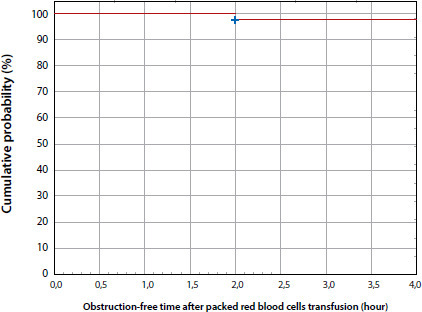
-
ORIGINAL ARTICLE09-23-2022
Validation of the Informal Caregiver Burden Assessment Questionnaire for Brazil – short version
Revista Brasileira de Enfermagem. 2022;75(4):e20210862
Abstract
ORIGINAL ARTICLEValidation of the Informal Caregiver Burden Assessment Questionnaire for Brazil – short version
Revista Brasileira de Enfermagem. 2022;75(4):e20210862
DOI 10.1590/0034-7167-2021-0862
Views0See moreABSTRACT
Objectives:
to cross-culturally adapt the short version of the Informal Caregiver Burden Assessment Questionnaire to the Brazilian culture and test its psychometric properties.
Methods:
the questionnaire was translated, adapted, and applied to a sample of 280 informal caregivers. The psychometric assessment was verified by estimating psychometric sensitivity and internal structure validity.
Results:
inter-rater agreement was satisfactory among specialists. In the seven-factor model, item (Q9) of the domain “Perception of Efficacy and Control Mechanisms” showed a factor loading less than 0.40 (ʎ = 0.26), and an alternative six-factor model was evaluated. However, both models showed excellent fit indices, and it was decided to keep the seven-factor reference model. Reliability was satisfactory for the seven subscales (α > 0.70).
Conclusions:
the questionnaire was adapted and showed adequate psychometric indices in the Brazilian context in which it was evaluated, preserving its original essence.
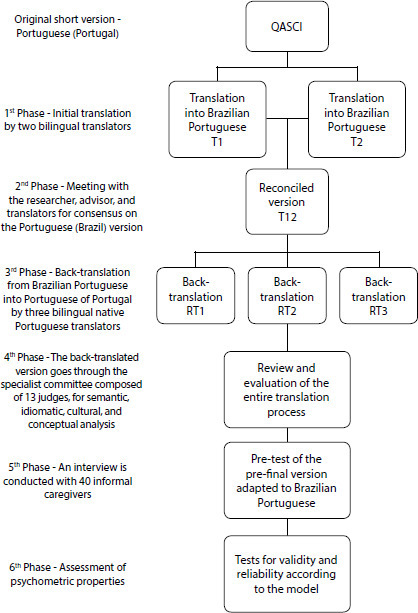
-
ORIGINAL ARTICLE09-23-2022
Analysis of the concept of cardiovascular risk: contributions to nursing practice
Revista Brasileira de Enfermagem. 2022;75(4):e20210803
Abstract
ORIGINAL ARTICLEAnalysis of the concept of cardiovascular risk: contributions to nursing practice
Revista Brasileira de Enfermagem. 2022;75(4):e20210803
DOI 10.1590/0034-7167-2021-0803
Views0See moreABSTRACT
Objectives:
to analyze the concept of cardiovascular risk to support nursing practice.
Methods:
this is an analysis to define the concept of cardiovascular risk, through the use of eight steps of Walker’s and Avant’s framework, using a literature review in indexed scientific journals.
Results:
cardiovascular risk is defined in a broad and original way as a context of health and nursing care that makes it possible to identify modifiable (cardiometabolic, behavioral, psychosocial, cultural and occupational) and non-modifiable (biological) risk factors for cardiovascular diseases that act as early and interrelated markers, of multiple and heterogeneous etiology, predisposing to cardiovascular vulnerability.
Conclusions:
with the analysis and definition of the concept of cardiovascular risk, we realized that it will be possible to base nursing practice, with implications in clinical practice for identifying and reducing risk factors for cardiovascular diseases, with nursing relevance in the care of these subjects.
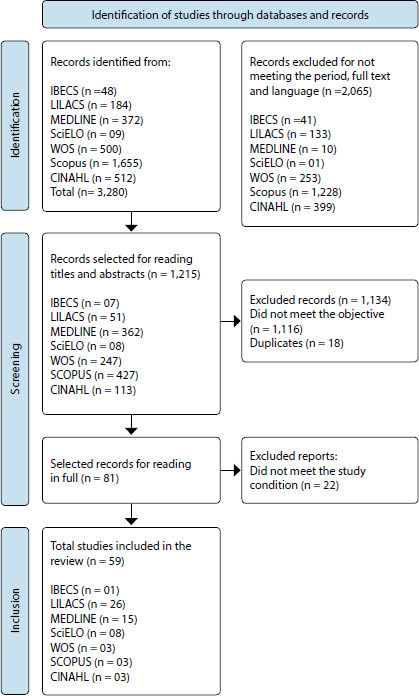
-
ORIGINAL ARTICLE09-23-2022
Brain death communication with parents of children and adolescents: care strategies
Revista Brasileira de Enfermagem. 2022;75(3):e20210943
Abstract
ORIGINAL ARTICLEBrain death communication with parents of children and adolescents: care strategies
Revista Brasileira de Enfermagem. 2022;75(3):e20210943
DOI 10.1590/0034-7167-2021-0943
Views0See moreABSTRACT
Objectives:
to identify care strategies developed by professionals from critically ill patients’ units in communicating BD with parents of children and adolescents.
Methods:
an exploratory and descriptive research with a qualitative approach, carried out in two health institutions between October and December 2019, through semi-structured interviews. Data analysis took place through content analysis.
Results:
twenty-one professionals participated. Three care strategies were identified: actual clinical situation in suspected brain death; sensitizing families to the real clinical situation after brain death diagnosis; and time to assimilate the death information.
Final Considerations:
the care strategies for communicating brain death to families identified in this study present the possibility of subsidizing health managers in training and support promotion for professionals in care practice. Moreover, they can be incorporated and validated in the care practice of the studied context.
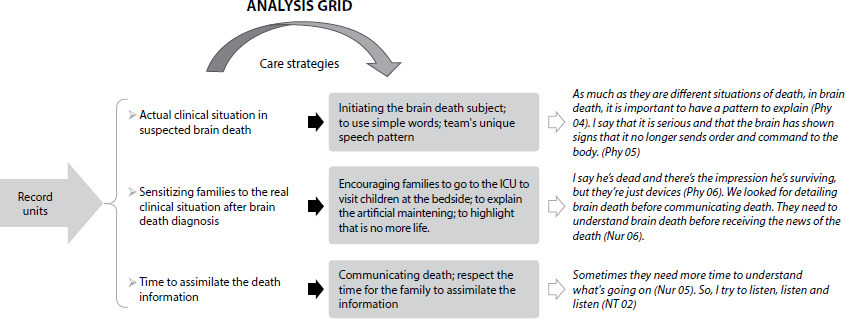
-
08-01-2022
Monkeypox: between precision public health and stigma risk
Revista Brasileira de Enfermagem. 2022;75(5):e750501
Abstract
Monkeypox: between precision public health and stigma risk
Revista Brasileira de Enfermagem. 2022;75(5):e750501
DOI 10.1590/0034-7167.2022750501
Views0The World Health Organization (WHO) is on alert due to an unprecedented Monkeypox outbreak in non-endemic countries, such as Europe, which have been affected recently. Despite the low pandemic potential, the recent SARS-CoV-2 pandemic has contributed to heightened levels of public concern in the face of the threat of new global health emergencies().As of May […]See more -
ORIGINAL ARTICLE10-18-2022
Methodological path to reach the degree of saturation in qualitative research: grounded theory
Revista Brasileira de Enfermagem. 2022;75(2):e20201379
Abstract
ORIGINAL ARTICLEMethodological path to reach the degree of saturation in qualitative research: grounded theory
Revista Brasileira de Enfermagem. 2022;75(2):e20201379
DOI 10.1590/0034-7167-2020-1379
Views0See moreABSTRACT
Objectives:
to achieve the degree of saturation in study that applied the grounded theory.
Methods:
qualitative research, carried out in four Family Health Units, between June 2018 and May 2019. The data from the interviews with 30 health professionals and non-participant observation were coded in the stages: open, axial and integration.
Results:
the degree of saturation was achieved by two conceptual models – theoretical saturation and inductive thematic. Theoretical saturation was considered: the development of conceptual codes and observation, in the collection and analysis of data, when they generated new categories/subcategories or only indicated increasing instances. For thematic inductive saturation, the use of new codes based on each interview stood out.
Final Considerations:
the visual layout for the number of codes, the theoretical scope of the concepts and the delimitation of the sample groups guided the identification of the degree of saturation for the development of the conceptual body that supported the substantive theory.
-
ORIGINAL ARTICLE11-02-2020
Transitional care from hospital to home for older people: implementation of best practices
Revista Brasileira de Enfermagem. 2020;73:e20200187
Abstract
ORIGINAL ARTICLETransitional care from hospital to home for older people: implementation of best practices
Revista Brasileira de Enfermagem. 2020;73:e20200187
DOI 10.1590/0034-7167-2020-0187
Views0See moreABSTRACT
Objective:
to assess the conformity of nursing care concerning best evidence in transitional care from hospital to home for older people.
Methods:
a project to implement best evidence based on the model proposed by the Joanna Briggs Institute in surgical clinic of a university hospital with older people, caregivers or family members, and nurses, between July and August 2019. Eight evidence-based criteria have been audited through interviews, medical records and computerized system, presented in percentages.
Results:
the highest non-compliance rate found in a baseline audit was absence of continued training on transitional care and hospital discharge plan. Identifying barriers to best practices included educational programs; afterwards, there was an improvement in compliance rates in all the criteria assessed.
Final considerations:
the criteria based on audited evidence showed an increase in compliance rates with the strategies implemented, contributing to improving transitional care for older people.

-
ORIGINAL ARTICLE11-06-2020
Digital inclusion and Internet use among older adults in Brazil: a cross-sectional study
Revista Brasileira de Enfermagem. 2020;73:e20200241
Abstract
ORIGINAL ARTICLEDigital inclusion and Internet use among older adults in Brazil: a cross-sectional study
Revista Brasileira de Enfermagem. 2020;73:e20200241
DOI 10.1590/0034-7167-2020-0241
Views0See moreABSTRACT
Objectives:
To describe the profile of Brazilian older adults who use the Internet, the means of Internet access and the purpose of Internet use and to verify the existence of association between socio-demographic variables and variables related to Internet use.
Method:
Cross-sectional study with Brazilian older adults who used the social networks Facebook and WhatsApp. Descriptive, univariate, and bivariate analysis were conducted.
Results:
384 older adults participated in the study, mostly women (52.08%), with a mean age of 64.6 years old and who used the Internet to address health concerns (65.36%). The main activities on the internet were reading, listening to music, playing games, watching videos and photos (37.30%). The main benefits pointed out were interaction (74.5%), learning (19.2%) and entertainment (19.25%). There were statistically significant differences between time spent online and the variables gender, age, and civil status.
Conclusion:
This study showed characteristics of older adults who use the Internet and revealed the possibility of using digital technologies to optimize health care for this population.
-
ORIGINAL ARTICLE03-30-2020
Clinical simulation in teaching Pediatric Nursing: students’ perception
Revista Brasileira de Enfermagem. 2020;73(2):e20180720
Abstract
ORIGINAL ARTICLEClinical simulation in teaching Pediatric Nursing: students’ perception
Revista Brasileira de Enfermagem. 2020;73(2):e20180720
DOI 10.1590/0034-7167-2018-0720
Views0See moreABSTRACT
Objectives:
to comprehend the perception of undergraduate nursing students about learning to care for the child and family through clinical simulation.
Methods:
this is a qualitative research conducted with ten nursing students through semi-structured interviews. Data were analyzed through content analysis.
Results:
data were organized into two categories: “learning a new way to learn,” in which students describe their experiences during the simulation, and “learning a new way to care,” in which they reflect on learning through simulation.
Final considerations:
we believe that clinical simulation practice in teaching should be encouraged because of the benefits it can offer to the students, faculty, patients and their families. However, we recommend further studies to validate scenarios of child and family healthcare.
-
ORIGINAL ARTICLE11-10-2022
Effect of educational video on newborn care for the knowledge of pregnant and postpartum women and their families
Revista Brasileira de Enfermagem. 2022;75:e20201371
Abstract
ORIGINAL ARTICLEEffect of educational video on newborn care for the knowledge of pregnant and postpartum women and their families
Revista Brasileira de Enfermagem. 2022;75:e20201371
DOI 10.1590/0034-7167-2020-1371
Views0See moreABSTRACT
Objectives:
to evaluate the effect of educational video on newborn care to increase the knowledge of pregnant, postpartum, and family members.
Methods:
a quasi-experimental study, with pre-intervention and post-intervention evaluation with a single group. Fifty-eight pregnant, postpartum, and family members treated in basic health units and a hospital in Ceará, Brazil, participated. The study used the McNemar and binomial tests for the analysis.
Results:
after the intervention, there was an increase in the frequency of hits, from 70.82% to 92.97%. Most of the questions presented a significant increase of hits (p < 0.05) with an emphasis on sleeping position, drying of clothes, free demand for breastfeeding, and things to avoid (such as accessories in the sleeping place and talc in diaper change).
Conclusions:
the educational video was effective to participants in acquiring knowledge on the care of newborns and can assist in health education activities carried out by nurses.
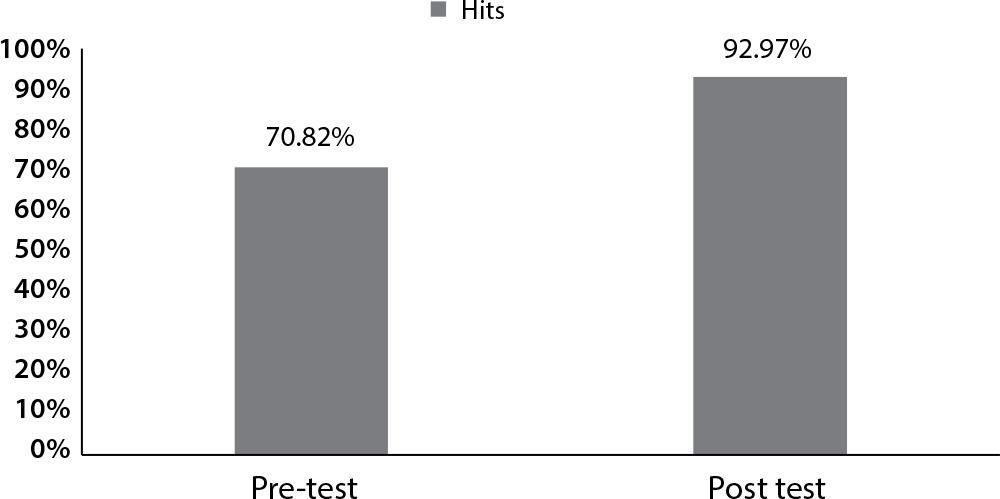
-
ORIGINAL ARTICLE10-21-2019
Practice challenges in patient safety
Revista Brasileira de Enfermagem. 2019;72(6):1504-1511
Abstract
ORIGINAL ARTICLEPractice challenges in patient safety
Revista Brasileira de Enfermagem. 2019;72(6):1504-1511
DOI 10.1590/0034-7167-2018-0441
Views0See moreABSTRACT
Objective:
to understand the professional practice challenges in reaching the goals and objectives of the National Patient Safety Program (Programa Nacional de Segurança do Paciente).
Method:
qualitative case study, based on the Comprehensive Sociology, carried out with 31 professionals from the Patient Safety Center (Núcleo de Segurança do Paciente) and the nursing team, working in a teaching hospital. Data collection took place between May and December 2015 through interviews, observation and documentary analysis. The analysis proceeded according to the prerogatives of the Content Analysis.
Results:
three categories emerged: the prescribed reality; material resources and their impact on care; and human resources related to the reality.
Final considerations:
challenges to safe professional practice are caused by inadequate physical structure, insufficient physical and human resources, but mainly invade the transition from the prescriptive reality scope.
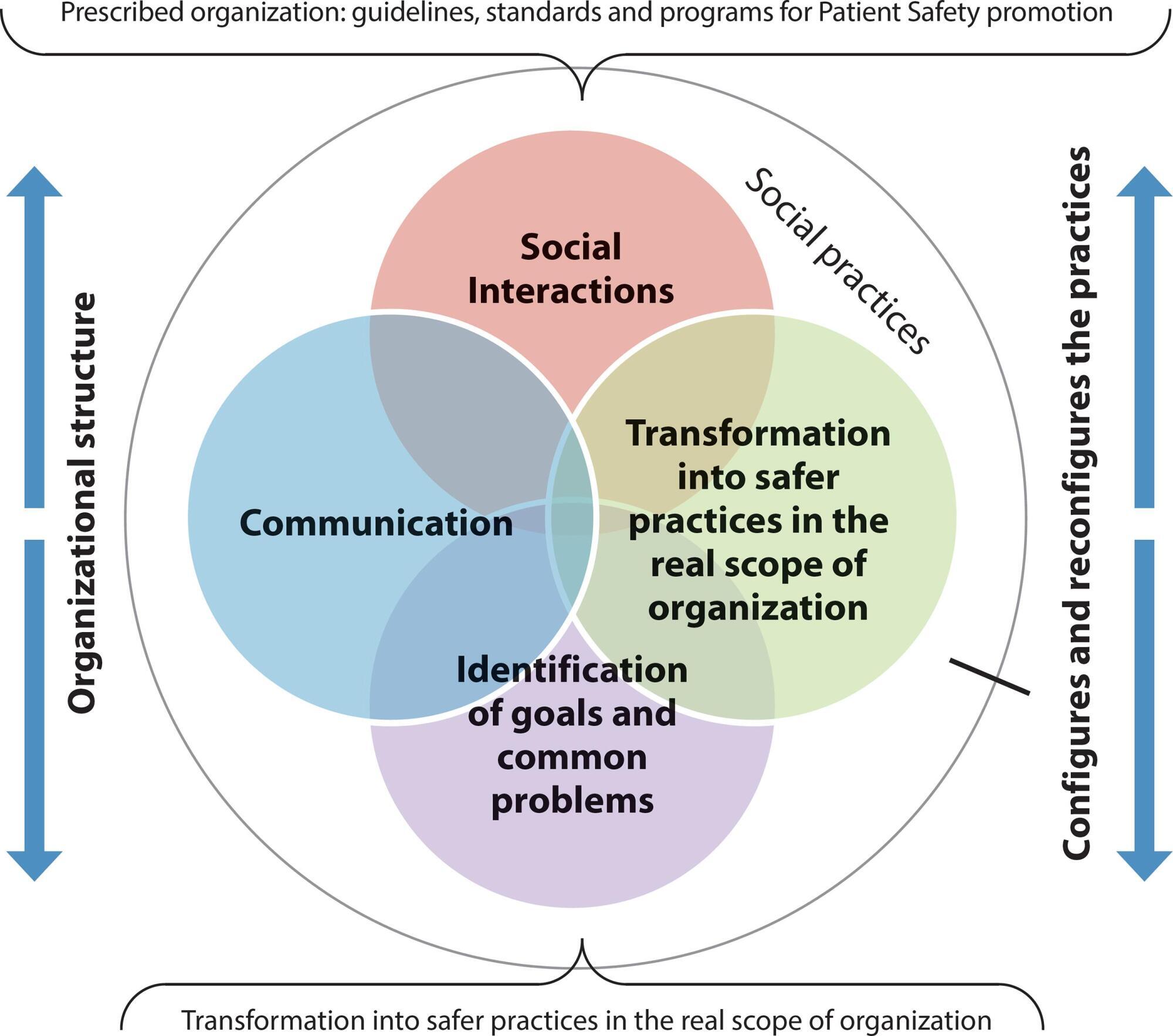
-
REVIEW09-30-2020
Telenursing in care, education and management in Latin America and the Caribbean: an integrative review
Revista Brasileira de Enfermagem. 2020;73:e20190317
Abstract
REVIEWTelenursing in care, education and management in Latin America and the Caribbean: an integrative review
Revista Brasileira de Enfermagem. 2020;73:e20190317
DOI 10.1590/0034-7167-2019-0317
Views0See moreABSTRACT
Objective:
Analyze the knowledge generated about telenursing related to the roles of nurses (care, education and management) in Latin America and the Caribbean, based on scientific evidence.
Methods:
Integrative review, for the years 2009 to 2019, in scientific databases from Latin America and the Caribbean. Twelve articles were selected.
Results:
Nine studies focused on care and three on education. The information and communication technology used in the studies was telephony directed toward non-communicable diseases. There were concerns about the remote communication process. With respect to education, two focused on educating health teams and one on educating patients.
Conclusion:
It is necessary to conduct studies on telenursing that generate changes in care practices, explore information and communication technology resources and provide communication training focused on this new care model.
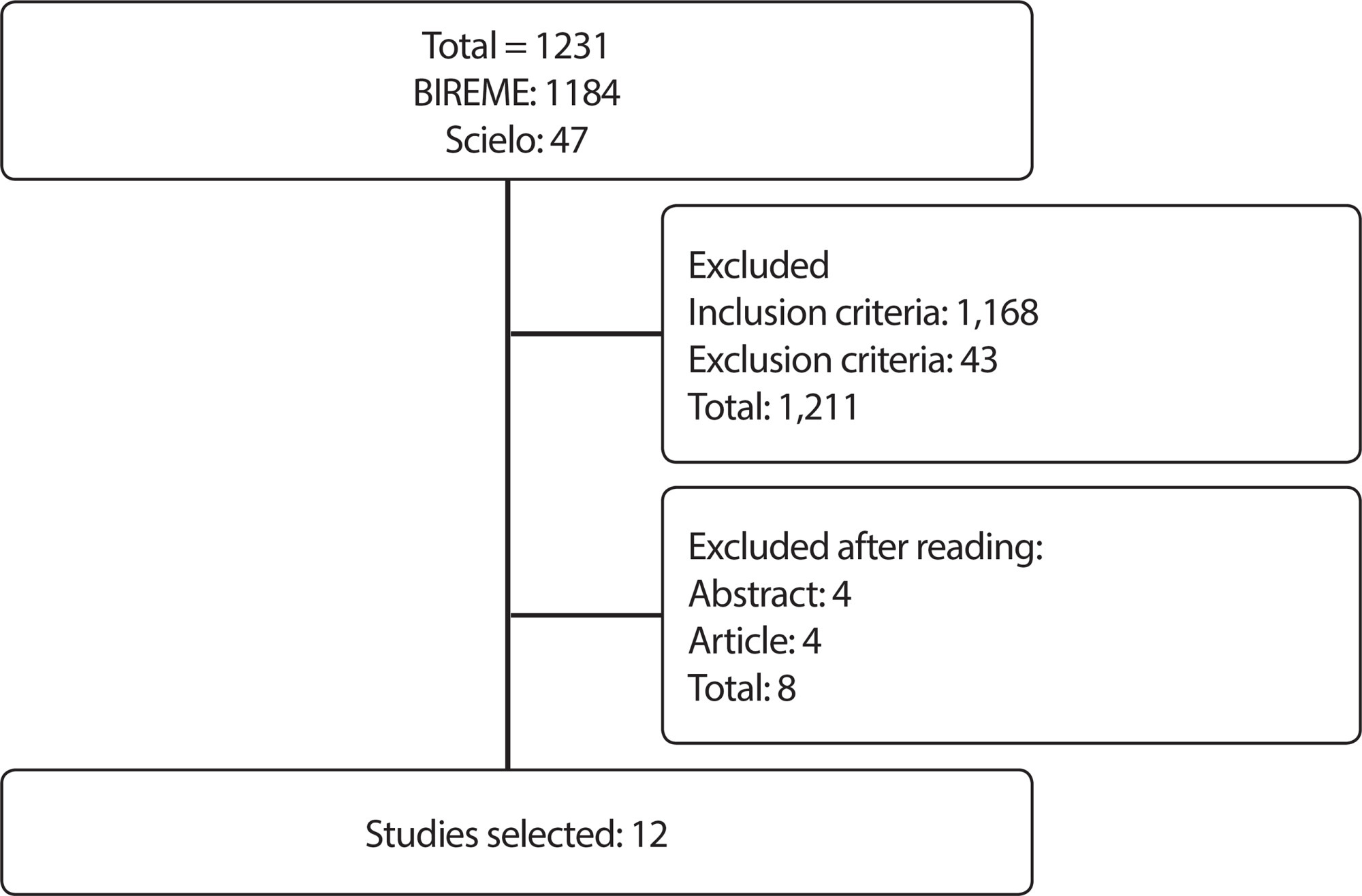
Search
Search in:
Nuvem de Tags
Enfermagem (930)Cuidados de Enfermagem (269)Atenção Primária à Saúde (239)Idoso (208)Educação em Enfermagem (151)Segurança do Paciente (150)Saúde Mental (145)Educação em Saúde (139)Estudos de Validação (131)Qualidade de Vida (104)Tecnologia Educacional (100)Promoção da Saúde (99)COVID-19 (91)Criança (91)Família (87)Enfermagem Pediátrica (86)Saúde do Trabalhador (86)Adolescente (85)Saúde Pública (82)Estudantes de Enfermagem (77)



